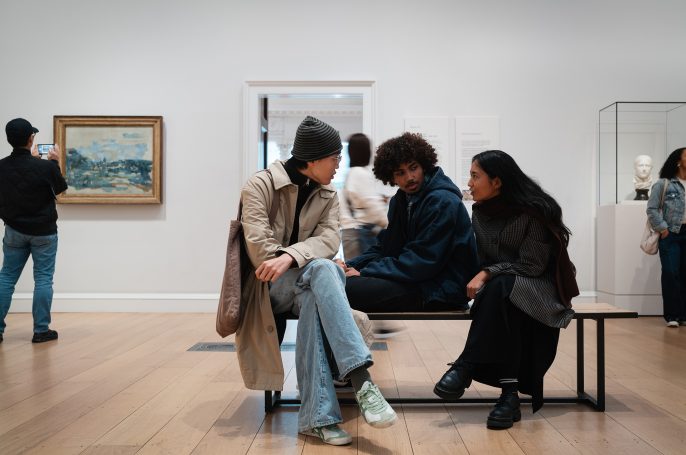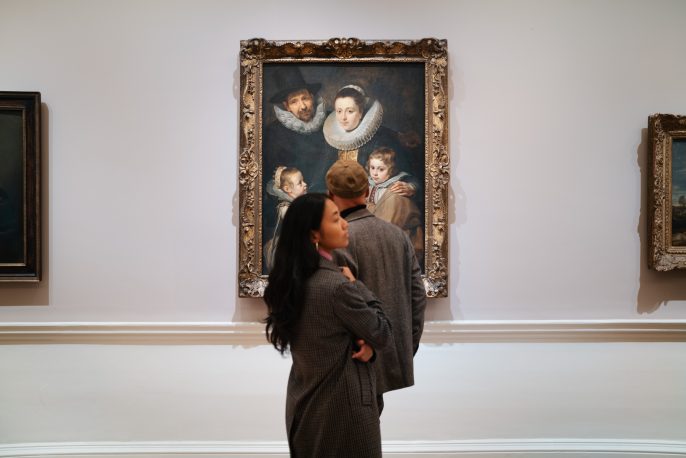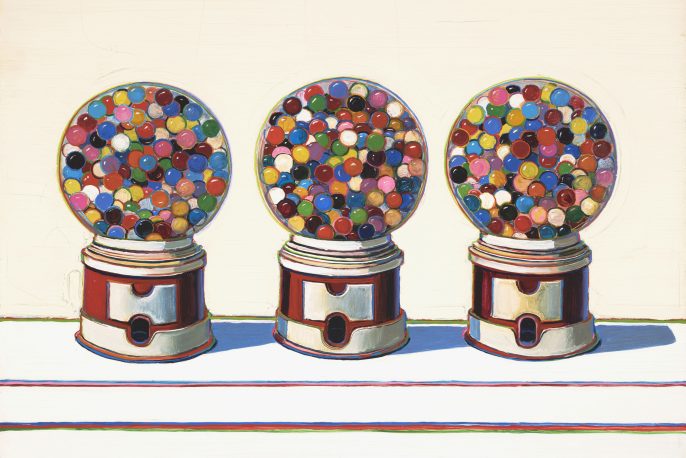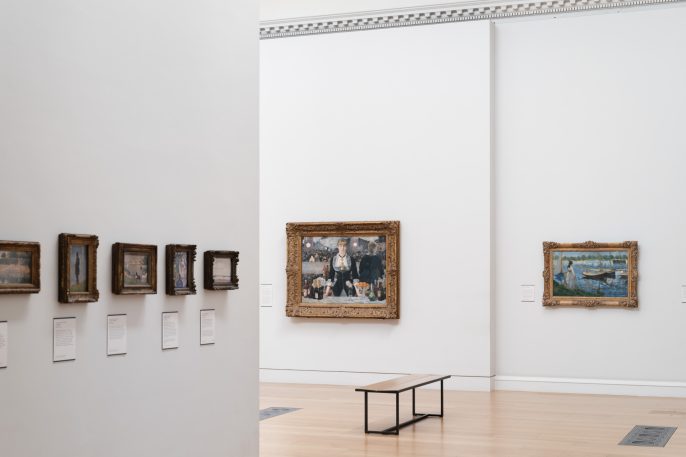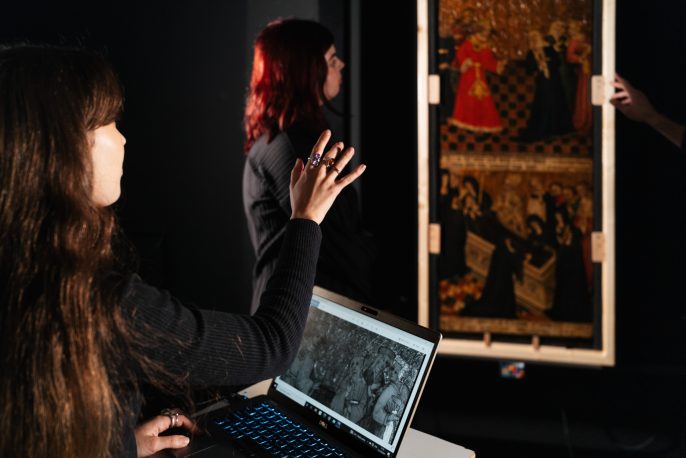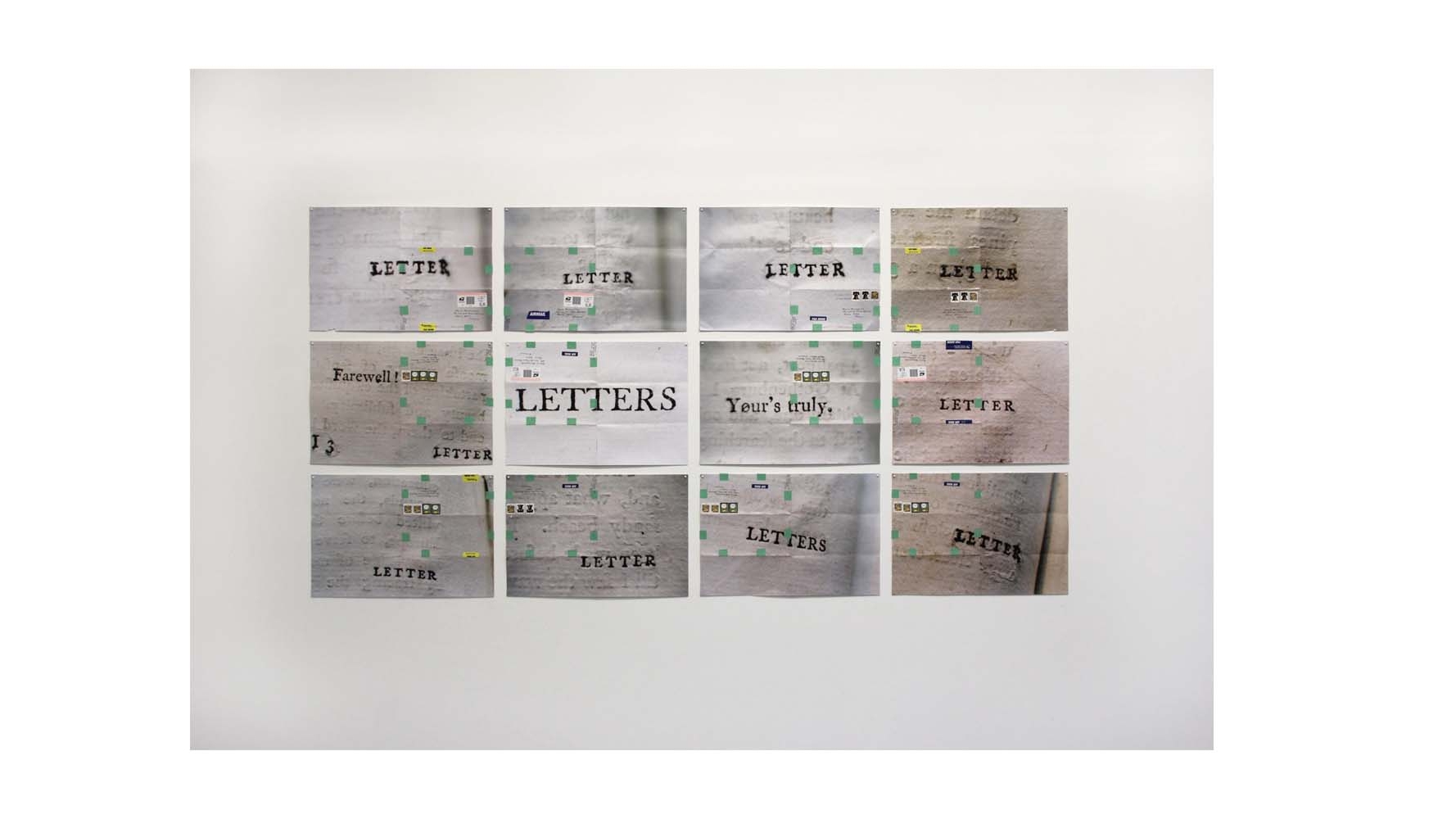
“What a Hazard a Letter Is”: Correspondence in Feminist Art, Art Writing, and Art History, from Emily Dickinson to Now [Archived]
This series of events newly figured the role of the researcher as working, thinking, feeling, and writing in close proximity to their subject, to explore the meanings and manifestations of ‘correspondence’ in feminist art, art writing, and art history. Correspondence refers to a type of communication, historically gendered or feminised, that occurs when letters are exchanged; it is also the label attached to an archival box storing and conserving them long after they have been written and sent. Correspondence collects the written pieces of our intimate, social, sexual, and working lives, which can be private or public, or both, and which extend from typed or handwritten sent letters, to drafts of letters, and unsent letters: emails, fan letters, marginalia, messages, open letters, postcards. These are the materials with which we ‘correspond’, form relational networks with and for each other: across mutual spaces of reading and writing, touching and feeling. To correspond is to ‘keep in touch’; to be together; to respond, reply, relate. As a term, correspondence is stretchy, and can send us in multiple directions, from the materiality of the letter, to the associations, agreements, affinities, close connections, and similarities that can occur between subjects, objects, artworks, and things.
Consisting of talks, artist-writer masterclasses, performative readings, works-in-progress presentations, and participatory workshops, this 2021-2022 series of events set out to explore the sticky relationship between correspondence as an object to be studied, and correspondence as an affective position that underpins and sustains our feminist lives and work: the entanglement of our lives within our work. It moved beyond cultural and art historical studies of the letter, to think newly and seriously about practices of letter writing and correspondence as inventive, feminist methods of art historical research. It aims to consider the ways in which corresponding, connecting, associating, and feeling with artists, subjects, and objects across time, could represent new ways of ‘doing’ feminist art historical research that prioritises affective, embodied, experimental writing and the blurring of subject and object. In this way, and following recent, ‘post critical’ theorisations and experimentations, such as Maggie Nelson on/with autotheory (2015), Paul B. Preciado on/with the ‘body essay’ (2008, trans. 2013), Saidiya Hartman on/with ‘critical fabulation’ and waywardness (2008, 2019), Carol Mavor on/with imaginative archives (2020), Tina Campt on/with listening to images (2017), and Julietta Singh on/with body archives and queer mothering in letters (2018, 2021), the series sought to create a space that sits between feminist theory and practice wherein new dialogues between art making, art writing, and art history can speak capaciously to one another (and correspond). How can taking risks with literary form, like the writing of a letter that is also a “hazard” (to steal Emily Dickinson’s description that she pencilled onto the unfolded pattern of an envelope), open up new ways of taking risks with content?
Recognising the contribution feminist and queer artists and writers have made to transforming the once private, domestic tradition of letter writing—from the envelope poems of Dickinson, to the letter-poems of Diane di Prima, to the epistolary artworks and novels of Kathy Acker, to the open letters of Audre Lorde, to the epistolary art writings of Quinn Latimer—the series intends to explore the private-made-public forms, feelings, and materialities of their artworks and writings, and the urgent questions and constructions regarding gender, sexuality, class, race, embodiment, sickness, and ability they make. Departing from American art/writing practices, but always thinking about them in relation to others (subjects, disciplines, forms, contexts, geographies, nations, histories), the series asks what such letter-based/correspondence artworks afford us; how might they help us to access our subjects differently? What can we learn about them and their histories or desires, about ourselves, about the structure of our relationship, about the relations between past and present feminisms, by turning more closely to the affective, attentive, embodied, desiring, social, and speculative qualities of letter writing and correspondence as a feminist method of art historical research? What can correspondence—as a practice-based methodological turn—give us?
This series was organised by Dr Alice Butler (The Courtauld) and supported by the Centre for American Art.
Events
Thursday 9 December 2021
“‘How close can I get to someone? Will we become each other?’: Epistolary Subjects, Objects, and Methods in Feminist Art, Art Writing, and Art History”
Writing workshop with Dr Alice Butler
10am-1pm GMT online
Around Valentine’s Day, 1980: Kathy Acker and Cookie Mueller’s Lovesick Letter-pieces
Lecture by Dr Alice Butler
5:00-6:30pm GMT online
Dr Alice Butler is the Centre for American Art Terra Foundation Postdoctoral Fellow. She also teaches in Critical and Historical Studies at the Royal College of Art. An interdisciplinary scholar and art writer, she specialises in the intersections of feminist art and writing to explore questions of sickness, sexuality, and gender, via feminist and queer perspectives and experimental approaches to archive and autotheory. She has previously held fellowships with the Paul Mellon Centre, the Freud Museum London, and the AHRC. Recent publications include the article “‘Have you tried it with three? Have you?’ Ann Quin, Love Triangles, and the Affects of Art/Writing,” in Capacious: Journal for Emerging Affect Inquiry (2021) and the essay “Fan Letters of Love,” in Fandom as Methodology: A Sourcebook for Artists and Writers (2019). She has also recently published essays in the art writing anthologies ON CARE (2020) and ON FIGURE/S (2021). She is currently finalising work on a number of book projects, including a monograph on the sick desires and pleasures of Kathy Acker and Cookie Mueller’s interdisciplinary art writing, and a collection of essays, articles, and dialogues on gesture in feminist art and writing, within which she will be publishing new research on Francesca Woodman’s photography and autoeroticism. This intersects with a new project on the interrelation of textiles, sickness, and perversion, as represented and performed in feminist art practices, that she is researching during her Fellowship at the Centre for American Art.
Tuesday 10th May 2022
The Enveloped: Emily Dickinson and London’s Foundling Hospital
A very visual presentation to be followed by a writing workshop
Carol Mavor – Writer and Professor Emeritus, University of Manchester.
Like the Sea: Dancing with Mary Glass (1946-2021)
A very visual lecture with images and film clips
Carol Mavor – Writer and Professor Emeritus, University of Manchester.
5.00pm – 6.30pm BST, in person
Along with other women, who are dead or alive, who are real or fictional—Mary Glass is part of an invisible chain of dancers, painters, literary heroines, writers, figures from my life, who embrace my own story.
You are more myself than I am—I say to all of them—my self-same-siblings.
Mary Glass, who is wildly different than me, is closest to my heart.
When I was studying dance.
I wanted to be like Anna Halprin.
I wanted to be like Yvonne Rainer.
I wanted to be like Simone Forti.
I wanted to be like Ruth Beckford.
I wanted to be like Trisha Brown.
I deeply wanted to be Mary Glass (even if, at that time, I had never heard of her).
Mary Glass is an innovative dancer and choreographer, quietly instrumental to the San Francisco Bay Area art scene of the 1960s and 70s—barely known today—admired for her experimental movements based on sounds and images of the Pacific.
As a child, Glass took her first dance class with Anna Halprin on her famed redwood dance deck in Marin County, Calif. Dancing with the blue sky as her ceiling—surrounded by magical madrones and redwoods— the effect on Glass was seismic. Fittingly, Halprin called her classes “dance experiences.”
Glass’s lifestyle, anxieties and dance reflect—with her characteristic audible (and inaudible) quietude—the geography of Northern California (human, physical, environmental). ‘Happenings’, Zero Population Growth (ZPG), object-relations theory, feminism, Vietnam, ecology. Today Glass is remembered by an increasingly diminishing handful of devotees. I am one. Like “water in water,” we are like the sea.
Carol Mavor – Writer and Professor Emeritus, University of Manchester
Carol Mavor is writer who takes creative risks in form (literary and experimental) and political risks in content (sexuality, race in America, child-loving and the maternal).
Her Reading Boyishly: Roland Barthes, J. M. Barrie, Jacques Henri Lartigue, Marcel Proust, and D. W. Winnicott was named by Grayson Perry in the Observer as his 2008
‘Book of the Year.’
Mavor’s Blue Mythologies: A Study of the Colour ‘coaxes us into having a less complacent attitude…even when it comes to something as apparently innocuous as a color’ (Los Angeles Review of Books).
For Maggie Nelson, Mavor’s Aurelia: Art and Literature Through the Eyes and Mouth of the Fairy Tale is ‘enigmatic and as full of magic as its subjects.’
Max Porter sees Like a Lake as ‘a novella teasing an essay, or an erotic ghost haunting a fictional memoir, or a negative searching for its lost prints. It is an unnerving question-machine where desire, memory, loss and invention are staged, folded and held, tasted, re-made and undone. It’s a strange, vivid, troubling and beautiful book.’
Her Serendipity: The Afterlife of Objects is forthcoming from Reaktion Books.
Listen to Mavor in an interview on the color blue as part of Phoebe Judge’s intriguing series on love: https://thisislovepodcast.com/blue
Thursday 12 May 2022
Texts as Dinner Guests, or, Corresponding with Other Voices
artist-writer masterclass with Dr Sophie Seita
Decals of Love, or, The One True Imposter, a Lyric Lecture With/Through Some Queer Love Poems
lecture-performance by Dr Sophie Seita
5.00pm – 6.30pm BST, in person
In this lyric lecture on queer love poems, a perhaps-too-close reading, Sophie Seita treats poetic lines taken from Wendy Lotterman’s poetry as if they were part of their ongoing dialogue and epistolary friendship. The piece also thinks about ‘the prurient’ as an aesthetic category of queer interpretation, what it means to write about and ‘use’ our friends’ words, or to read queer poems to a lover, and in this way put a spin on the avant-garde’s proclaimed desire for social efficacy. The lecture also thinks and performs ‘form’ through what could be called experimental or dialogic criticism, letting texts or lines or voices correspond with each other on the page, sonically or visually, where argument and explanation emerge through association and juxtaposition. In this way, it’s also scenes of reading, modes of address.
Dear Wendy,
Yes to feelings as guests that one can properly address!
Wish me luck that my emotional quandaries will somehow magically resolve themselves.
Love,
Sophie
Sophie Seita is a London-based artist, writer, and educator whose work explores text in its various translations into book objects, performances, videos, or other languages and embodiments. She works internationally on several creative and critical projects; most recently and together with Naomi Woo, she’s co-created a performance and community-oriented public art project, rooted in speculative and collaborative research on queer-feminist gardeners, funded by the British Council, Canada Council, Canada High Commission, and Farnham Maltings. Other work has been shown at [SPACE], La MaMa Galleria (NYC), Printed Matter (NYC), Bold Tendencies, the Royal Academy, the Serpentine, Queer Art Projects, Flat Time House/Up Projects, Raven Row, Parasol Unit, Art Night London, the Arnolfini, Kunsthalle Darmstadt (Germany), JNU (New Delhi), Heong Gallery and Kettle’s Yard (Cambridge) and elsewhere. She is an Assistant Professor at Boston University, co-organises the interdisciplinary Sound/Text seminar at Harvard, and is a visiting tutor on the Alternative Education Programme at Rupert in Vilnius, Lithuania, and the MSt in Writing for Performance at Cambridge University. At the moment, she’s working on a book of experimental essays, titled Lessons of Decal; a book on performance art, called Literary Live Art, a translation of Uljana Wolf’s Etymological Gossip (forthcoming with Nightboat), and various performances and collaborations. More info on her performances, publications, and other projects can be found here: https://www.sophieseita.com/
Thursday 16 – Friday 17 June 2022
Together, With, To: A Workshop on Correspondence and Letters
Closed workshop for invited participants, with keynotes open to all – please follow the links to book to attend the lectures.
Thursday 16th June
13:30 Introduction
14:00 Alice Butler and Gemma Blackshaw
To Reply, To Risk, To Resemble: Bessie Bruce and Cookie Mueller
14:40 Fatema Abdoolcarim
A Desiring Crease: Correspondence and Longing Folded Into the Seated Scribe
15:20 Coffee break
15:40 Naomi Pearce
Handing the mail: ambivalence and the secretary in the archive
16:20 Closing remarks
17:00 Less Letters or, A Poetics: A lecture-performance by Quinn Latimer
Public Keynote by Quinn Latimer
(Unfortunately this event has been cancelled)
Who are you always writing to? What is the voice you’ve conceived for this address? Why so laconic? Why so desperate? Why does this distance seem like a kind of practice—designated for desire or its performance—or the ground for the construction of a practice, that is, the construction of a voice and its literatures and the aesthetics it advances? Is it possession that makes you address them by name, by first letter? Why so clingy? I mean, why do you always begin your letter with a letter—can’t you just spell it out? Why dear? Why stranger? Why bother? Why fill your screen with letters of petition, submission, recommendation, exhibition, resignation, boredom, war grief, economic imagery, pandemic news, signs of love and rage and other international communications? Dear L., This is my first letter to you…
For her keynote lecture-performance, Quinn Latimer will examine the letter—as literary form, as art criticism, as ideological sign, as ludic instrument, as international communications system, as feint of alienation and/or resistance. Letter as letter and letter as system. She will also consider the form of the lecture itself, as the letter’s oral-performative equivalent. Consider: In 1982, Christa Wolf began a lectureship at the University of Frankfurt by noting, “Ladies and gentlemen: This enterprise bears the title ‘Lecture on Poetics,’ but I will tell you at once, I cannot offer you a poetics.” Instead, Wolf offered: “I want to set a fabric before you. It is an aesthetic structure, and as such it would lie at the center of my poetics if I had one.” In the spirit of Wolf’s prophetic, Cassandra-like fabric, Latimer will place in front of you a letter, an aesthetic structure that somehow lies at the center of her poetics (if she had one). With this letter she will hash out that strange comfort we find in the ever-adaptable epistolary form—which scores our poems, phones, films, novels, affairs, friendships, songs, political resistance, domestic and public literatures—and what it offers us (writes to us) in return. While surveying the letter’s social, political, aesthetic, and gendered histories and futures, Latimer will also consider the standardization of national postal services and international communications, and their place in empire and our late capital systems. For letter by letter, our systems are constructed or resisted. Like language.
Quinn Latimer is a California-born poet, critic, and editor. Situated between the performance and the page, her writings often take in feminist imaginaries of literature and the moving image, technologies of gender and culture, and our many natures. She is the author of Like a Woman: Essays, Readings, Poems (2017), Sarah Lucas: Describe This Distance (2013), Film as a Form of Writing: Quinn Latimer Talks to Akram Zaatari (2013), and Rumored Animals (2012). She was editor-in-chief of publications for documenta 14 in Athens and Kassel. She is curator of SIREN (some poetics), opening at Amant Foundation, New York, in September 2022. Latimer is Head of the MA at Institut Kunst Gender Natur in Basel.
Friday 17th June
9:00 Arrival
9:15 Quinn Latimer masterclass
News From Home, a Workshop of Letter Genres
11:15 Coffee break
11:30 Amy Tobin
Howardena Pindell’s Correspondences
12:10 Karen Di Franco
dedicated to the destruction of all memories and societies. by including the memories of everyone in me. LOVE; how are you?
*The title is derived from Kathy Acker, written, c.1974. Fales Library and Special Collection, Kathy Acker Notebooks, box 2, folder 13: Jane Eyre II.
12:50 Catherine Grant
Dear Readers: intergenerational correspondence in feminist art and writing
13:30 Lunch
14:30 Natalie Ferris
Radical Notations
15:50 Nisha Ramayya
Correspondence as Rackety Bridge as Listening Oceanically
15:50 Daniela Cascella
Imaginary Conversations, Transcelations
16:30 Closing discussion
17:30 Writing to Images: The Practice of Corresponding with Art
Keynote by Tina Campt
In person and livestreamed.
In her most recent monograph, A Black Gaze, Tina Campt describes her practice of writing not as writing about, but rather writing to images. In this way, it constitutes a form of correspondence that aspires to dialogue with artists and artworks. In her keynote, Campt will expand upon this practice through an engagement with a series of works by black contemporary artists. She will explore the multiple frequencies and frequential valences of correspondence as an affective interchange and a dynamic of resemblance and re-cognition that is in no way limited to textual or epistolary forms. On the contrary, correspondence amplifies and enlivens the work of visual artists of color in ways that highlight the stakes of an ongoing conversation between the past, the present, and our aspirations for a future lived otherwise.
Tina M. Campt is Owen F. Walker Professor of Humanities Brown University, and is currently Visiting Professor in the Department of Art and Archeology at Princeton University. Campt heads the Black Visualities Initiative at the Cogut Institute for Humanities and is the convener of the Practicing Refusal Collective and the Sojourner Project. She is the author of four monographs and one edited collection: Other Germans: Black Germans and the Politics of Race, Gender and Memory in the Third Reich (2004), Image Matters: Archive, Photography, and the African Diaspora in Europe (2012), Listening to Images (2017), Imagining Everyday Life: Engagements with Vernacular Photography (with Hirsch, Hochberg and Willis, 2020) and A Black Gaze (2021).


